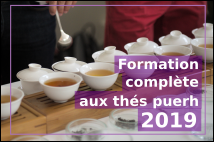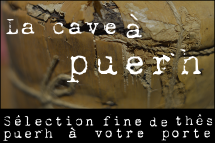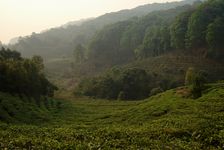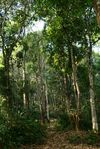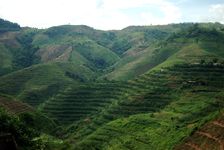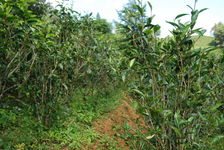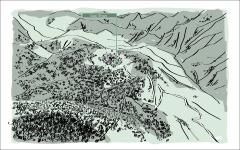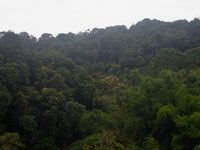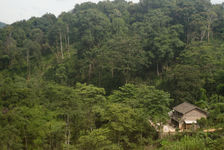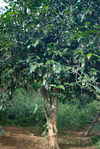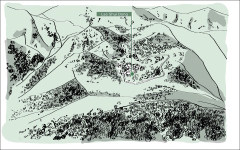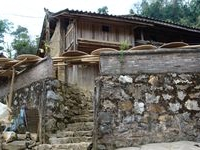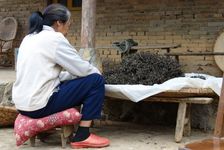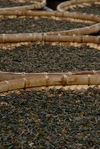 This page is not a real translation but just an automatic translation generated by computer of the original article, written in French language! Its not good... but better than nothing!
This page is not a real translation but just an automatic translation generated by computer of the original article, written in French language! Its not good... but better than nothing!Want to help us do diffuse puerh tea culture in english, by providing a better (or corrected) translation?
Please contact us!

Located east of Xishuangbanna, glued to the province Laossienne Phong Sali, Yi Wu is a mountain tea best-known Yunnan. Propelled to the front of the scene in the 1990s, the quality of teas this mountain tea are known from the 18th century.


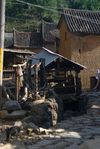

- 1.In the mountains of Wu Yi
- 2. Tea Garden in Yi Wu
- 3.Old village streets Yi Wu
- 4.Tea Garden in the drill Yi Wu
The concept of "mountain tea" dear lovers puerh (Pu Er tea) is misleading, especially Western, which tends to see a specific terroir and sets as you can have for wine. A wide variety of sizes, mountain tea refers indeed not a "mountain" as one might think, but a more or less often covering a number of hills and valleys separate area. If you often find a character to taste teas of the same mountain tea, they are generally not a land in itself, but more a "region" with its specific regionalized but may include various distinct terroirs, sometimes also straddling two different mountain tea.
These differences are partly attributable to heterogeneous altitudes between different soils of the same mountain, which sometimes extend over nearly 1,000 meters, but also by large exposure of these soils differences, and differences in soil types that may be encountered within the same mountain tea. Added to this is the crucial point, but often forgotten, that is the nature of trees. Behind the name catch all "variety of Yunnan large leaf" is actually more than a hundred selections from tea plants, usually from mutation and natural crossing and distributed since ancient times so that the nature of trees in a valley to another can sometimes be significantly different.
The mountain tea is as is often the case in China blurred and subtle notion, and mountains teas are primarily their lives to complex historical alchemy that mixes land, geography, politics and local history.


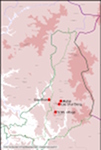
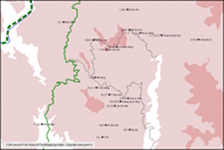
- 1.Xishuangbanna in Yunnan
- 2.Yi Wu in Xishuangbanna
- 3.Three famous villages of Yi Wu
- 4.Area around the village of Wu Yi
The "mountain" of Yi Wu, which it is very difficult to find the boundary on a map, which is banned in China to publish an accurate map, and is part of the complex mountains of Yunnan tea and covers an area stretches almost 50km from north to south and about 38km from east to west at its widest point, with altitudes between 600m and 1800m and includes a number of villages sometimes distant from each other as Guafengzhai east (15km as the crow flies from the village of Wu Yi) or Ding Jia Zhai north (not far from 10km as the crow flies from the village of Wu Yi).
If it there's a good taste "character" recognized Wu Yi teas, and a profile that share a number of teas from this area, Wu Yi teas, however, offer a nice taste variety, from first to tree very different ages (intensive culture shrub, with ancient trees through a number of transitive trees and a few wild trees still persist in some areas of Yi Wu) from different varieties tea plantations, but also distinct terroirs.
With the refinement of the land and the requirement of amateurs, various villages of Yi Wu began to be recognized in recent years, and if it there's some time we spoke generally of "Wu Yi Tea" is tea from the land attached to one of these villages today puts forward names as Maheizhai, Gao Shan, Gua Feng Zhai or Ding Jia Zhai, and more and more fans and seek today . Prices of different stars villages Wu Yi also fluctuate from year to year, sometimes dramatically, depending on the rating of a particular village and fads.
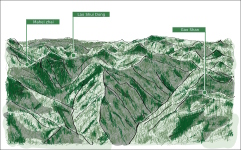
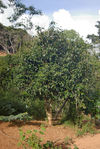
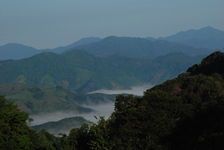
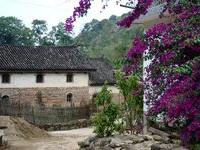
- 1.Gao Shan Shui Maheizhai and Lao Dong
- 2.Old tree Gao Shan
- 3. allentours of Maheizhai
- 4.Village of Lao Dong Shui
I would like to illustrate this with you today three maocha high quality, harvested at the same time, from the very first leaves of spring 2013 old trees three renowned villages of Yi Wu:Maheizhai, Gao Shan and Lao Shui Dong. I deliberately made the choice of three very close villages, all located south of Yi Wu within 5km as the crow flies from the old village of Wu Yi, not villages very far from each other as Gua Feng Ding Jia Zhai Zhai or to highlight the permanence and differences that may be encountered in the old tea trees micro-terroirs as close to each other.
It is however not provide a general flavor character of these three villages, which would require a much longer article and many more examples, but to see that the first spring leaves three villages can tell us About Wu Yi and their original lands.
Gao Shan
We begin our exploration with a beautiful old trees maocha Gao Shan. Gao Shan, a small village of 365 inhabitants is located 9 km by road from the old village of Wu Yi and belongs to the group of the latter village. It is however by actually located on the same mountain village of Wu Yi, and is separated from the latter by a small narrow valley through which the road that takes you to the village of Wu Yi Gao Shan is in front of the other village of Wu Yi over the road, perched at an altitude of 1161m on the eastern side of a small mountain peaks around 1300m. It is on this side of the mountain, between 1000m and 1300m that is attached to the bulk of the town of Gao Shan ancient trees.
The prices of Gao Shan continues to rise in recent years, and the price of tea this year exceeds Gao Shan Shui Lao Dong or Mahei Gao Shan Zhai making the most expensive town in the south of Yi Wu
 Chargement du thé...
Chargement du thé...Mahei Zhai
We continue our tour with a maocha old trees from another very famous village of Yi Wu:Mahei Zhai, a small village of 328 inhabitants. Located as Gao Shan 9km from the old village of Wu Yi, Zhai Mahei is located north of the village of Wu Yi and does not belong to the same group but village has its own village group, including Lao Dong Shui we talk later.
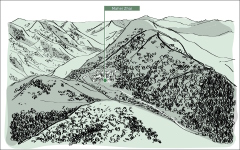
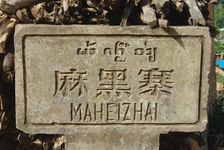
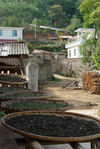
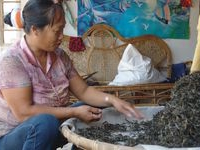
- 1.Village Maheizhai
- 2. Plate village Maheizhai
- 3.Tea leaves drying Maheizhai
- 4.Sorting sheets in a producer Maheizhai
At 1331m altitude, Mahei Zhai is on a mini shelf on the northeast side of a mountain rising a little over 1500m above sea level and located north of the village of Wu Yi, and is separated one of the latter by mountains. It is therefore the road around the mountain, then along the north pan through Shui Lao Dong Mahei to reach at least borrow the old trail that crossed the mountains and connects Yi Wu Shui Lao Dong.
The old trees are located Mahei Zhai to live outside the village, on the slopes of this mountain ranging from 1200m to 1400m.
 Chargement du thé...
Chargement du thé...Lao Shui Dong
From Maheizhai we join Shui Lao Dong, a very small village where some thirty families live, barely more than 100 people, and where we finish our tasting. Very close to Maheizhai, Lao Shui Dong is located less than 2km as the crow flies from that belongs to the same group of villages.
Slightly Southwest Maheizhai, Lao Dong Shui is perched slightly lower, at 1287m. If the two villages are located on the same mountain, they are separated by a summit Maheizhai is located on the north side of the mountain, and that Lao Shui Dong is on a sort of small bowl on top of a ridge go to the Southeast. It is this amazing dish which earned the village its name, evoking a hole formed by water, but also allows excellent exposure gardens Shui Lao Dong, not located on a slope very well on top of the mountain.
Much closer than was Maheizhai Gao Shan, we might expect more similarities between these two maocha, récoles on separate only a few kilometers ancient trees ... and yet:
 Chargement du thé...
Chargement du thé...Comparison and Conclusion
Liqueurs produced by these three teas are close, whether by their purity or clarity. However, the liquor tea Gao Shan appears slightly lighter than the other two, and the Lao Dong Shui as more bright and intense color.
The scent escaping from the lid Gaiwan leaves for his part well show the differences between these three maocha. Tea Shui Lao Dong seems much more soft, round and silky as the other two teas tested drier but more spicy. Among them tea Mahei is also distinguished by a greater force, a gross size and spicier than leaves Gaoshan.
The scents of tea and Mahei Gaoshan undeniably share something in common, especially a nice spicy dimension, although it is the most remote villages of our selection.
Faced with these two teas, maocha Shui Lao Dong is clearly part, incredibly soft, silky and bright, especially penetrating.
Substantially the same statement to the palace we will, with some obvious similarities between the Gao Shan and Mahei, including the excellent bouquet of invaded the nasal palate. At what distinguishes these two teas we note a greater force in the mouth, more bitter and more incisive dimension tea Mahei face than Gaoshan.
As preach perfumes, maocha Shui Lao Dong is clearly distinguishable from the other two, with a much softer and rounded character, the intense sensations silky, fine, fluids and less spicy.
Plunging his nose into the smell of Gaiwan the Mahei appears deepest, Gaoshan as fresher and lemon, and the Lao Dong Shui a gentleness, a perfume and a force incomparable penetration. The finding is the palace in the same direction, with a more masculine Mahei where Gaoshan and the Lao Dong Shui appear more soft and feminine. The Lao Dong Shui frankly out of the lot, with a silky, fruity and mild quite unusual.
This difference tea Shui Lao Dong address these two maocha Yi Wu is probably assign first place to the nature of trees where the tea leaves come. The character of the tea leaves all point not only to ancient trees, but probably also transitive, ie between wild and domesticated tree tree. If wild trees often lack taste interest, transitive trees when in fact it often emerge particularly sweet unique aromas, rich and deep as those that characterizes this tea Shui Lao Dong.
This can be seen by observing the infused leaves. Beautiful and very ridged, it reads clearly and for the three teas, the quality of the trees. However leaves Shui Lao Dong have areas with ocher colors and glowing, leaving again think of the transitive or wild tree ...
We will remember different things. From all three former three trees near the mountains of Wu Yi and villages harvested at the same time, these three teas share good taste some time, but also know well distinguish and express themselves through three distinct characters. The maocha of Mahei and Gao Shan have a flavor profile close enough, the Mahei is however characterized by a greater force, more bitterness, where is Gaoshan shines by its complexity and spicy dimension. The tea tasted Lao Dong Shui is against much more unusual, a roundness, softness and unmatched depth.
In the first spring differences can be noted in a village in Yi Wu to another view in the same village, a garden to another, or from one tree to the other during a single tree crops. But it also highlights, as these leaves Shui Lao Dong show very well the importance of the nature of the tree. If in the world of ancient trees puerh (Pu Er tea) attention is normally worn only on the land and on the age of the tree (often claimed or assumed), and not on the cultivar, as is the case for teas from newly planted gardens, the variety of the old tree has great significance when the results taste tea.
It is rare that the producer or family with a garden knows the nature of the trees that grow. However, there recency more than a hundred varieties of tea large leaf in Yunnan. From a mutation and crossover that took place as the centuries, these varieties are found distributed in different places of Yunnan, and can thus often more than the climate or the soil, stain the character set or a local given.
In contrast to the mountains tea or villages of origin teas are not controlled as there is for example in France for wine, and therefore require the use of certain cultivar based local names, we naturally find large differences between the same village teas depending on the nature of trees used and we will not be surprised to find more differences between a transitive Shui Lao Dong garden and a garden of old plantation of the same village that we find in tea gardens between Wu Yi very distant and sharing different natural conditions, or grow more similar trees.
Cover photos and teas Copyright Sébastien Vacuithé - vacuithe.blogspot.com

